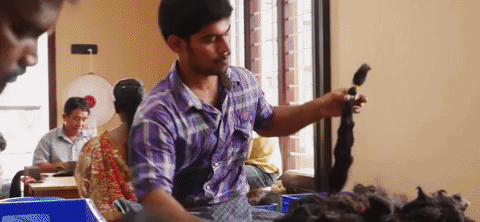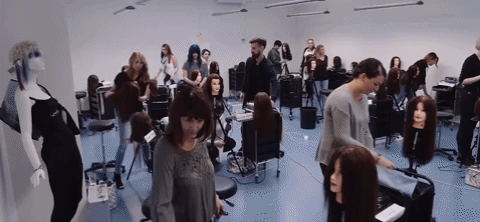True or False: What You Didn’t Know About Hair Extensions
Hair extensions make up a huge part of the industry’s business, and they’re a profitable service to have in your salon—but do you know where the hair comes from, or who the hair comes from? You’re familiar with claims like “real European hair” or “100 percent Remy human hair,” but what do they mean? Keep reading, because we explain it all with the help of Great Lengths’ National Program Director Brett Butcher.
How much do hair extensions cost? And how much should you charge? Click here!
True or False: Most hair for extensions comes from Europe.
FALSE: Brett says that European extensions don’t really exist—and if they do, they’re super expensive. “Go to Europe,” says Brett. “Women are not lining up on the streets to donate their hair.” So where DOES the hair come from?
- Great Lengths sources its hair from temples in India, where men and women donate their hair as a sacrifice to their gods and goddesses.
- Because hair donation is a religious offering, those who donate take extreme care of their hair, meaning it’s healthy and high quality.
- Temples sell hair donations to make money for the temple’s community.
- Indian hair and texture is similar to the texture of American and European hair—the strand is typically very fine.

True or False: Chemically-treated hair can’t be used for extensions.
TRUE: Great Lengths ensures that the hair used in its extensions has never been chemically treated.
- The company has a facility in India where employees inspect and purchase hair from temples.
- From the moment the hair is donated, it’s in the hands of Great Lengths employees.
- The facility cleans and tests the hair to verify it has never been chemically treated.
- If the hair is chemically treated, Great Lengths won’t use it because it will alter the company’s depigmentation process.

True or False: To make blonde extensions, companies just bleach the hair.
FALSE: Only Great Lengths uses a patented depigmentation process that is ammonia- and bleach-free.
- Once the hair is processed in India, Great Lengths hair is flown to the company’s Italian factories.
- The depigmentation process is done via osmosis, which the company learned from a textile manufacturer that uses it to remove color from wool, and it will not compromise the integrity of the hair.
- The process is incredibly gentle and keeps the hair strong, creating a higher-quality weft of hair. Here’s how it works: The Great Lengths process removes the whole color molecule from the hair and replaces it entirely with the textile dye color, resulting in colorfast hair that’s in virgin-like condition.
- When using ammonia or bleach, the process doesn’t remove the entire color molecule. Instead, it shatters the molecule and is then filled in with new color (which can be prone to fading).
True or False: You don’t really need to be trained to install extensions.
FALSE: Brett explained that the Great Lengths training process is intense because Great Lengths is with the hair for every step of its journey, from India to the salon—so stylists should know how to properly work with high-quality hair in order to complete the high-quality service for their clients.
- Great Lengths has a three-day, hands-on course that hairdressers must take to become Great Lengths-certified.
- In the course, stylists dedicate four to five hours to theory, with the rest of the time (about 17 hours) for hands-in-hair training.
- Great Lengths works selectively with salons to make sure that if a hairdresser is going to invest in the training, the salon where he or she works will be able to sell the service.

Check out the video to see the whole process!
More from
Great Lengths
-
Hair Extensions
6 Tips For The Flat Iron Waves Clients Want
-
BTC Hair Trend Report
VANESSA HUDGENS’ BRAIDED SPIKY BUN AT THE 2023 MET GALA
-
BTC Hair Trend Report
ASHLEY GRAHAM’S FLIPPED-OUT BOB AT THE 2023 MET GALA
-
BTC Hair Trend Report
Lily James’ Met Gala Twisted Bun + Piecey Fringe
-
Hair Color
Chemical-Free Money Piece? Here’s How!
-
Extension Application
3 Secrets For Invisible Extensions (Even On Ponytails!)
-
New Appointments
Great Lengths USA Appoints Justine Marjan As Brand Ambassador
-
Celebrity
Met Gala 2021: See The Best Celebrity Hair & Beauty Looks!
-
Celebrity
Jennifer Lopez’s Western-Inspired Ponytail
-
Blonde
Hilary Duff’s Creamy Blonde
-
Facebook Lives
Make More Money With This Extension Tip!
-
Hair Extensions
GL Pre-Bonded
-
Hair Extensions
GL TAPES+
-
News
Nine Zero One Salon Celebrates 10-Year Anniversary
-
Hair Extensions
4 Tape-In Extension Styling Must-Dos
-
Hair Extensions
6 Tape-In Extension Mistakes And How To Fix Them
-
Hair Color
Watch: Tape-In Extension Application For Chemical-Free Color
-
Best of 2018
The Extension Education You Need Before 2018 Ends
-
Hair Extensions
Asymmetrical-Twisted Updo
-
Braids
Video How-To: Tape-In Extension Application, Blending & Romantic Braid Styling
-
Hair Color
Coloring Tape-In Extensions: 3 Questions And Answers
-
Hair Extensions
5 Before-And-After Extensions Transformations You Have To See
-
Hair Extensions
Tape-In Extensions: 5 Things You Can’t Forget
-
#THEBTCSHOW 2018
Co-Lab Styling at #thebtcshow 2018









